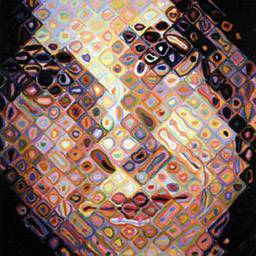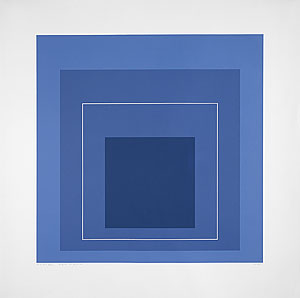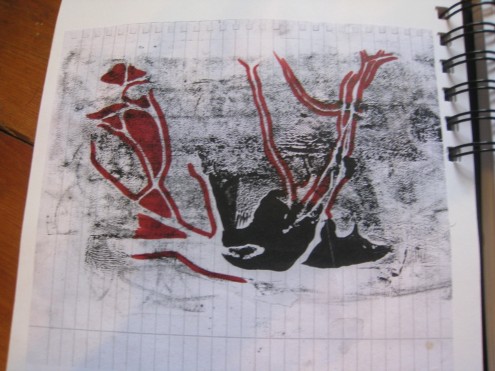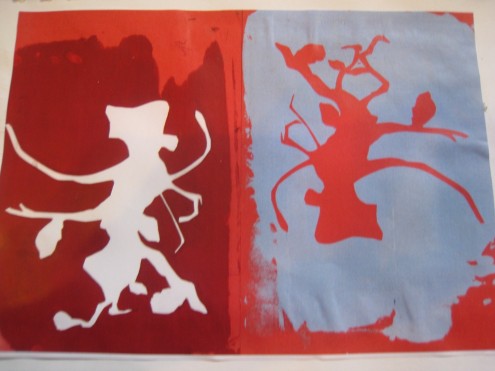Printmaking
Printmaking Artists

Chuck Close is an American painter and photograther, famed for his large scale phot-realistic paintings. Close has a unique visual style, his work appears very reminisant of a mosaic and also a very photo realistic feel. Extremely bright coloures murge with fleshy tones to create a slightly surreal effect, each shard of the person welded together beautifully to create the finished image. it kind of reminds me of looking through a crystal, the image is still whole, but distorted with tiny specs of brilliant rainbowed colour.
In this piece ‘Maggie’ (1996) the effect appears to cover the whole face, however in other works it can be seen to only cover a section or not at all.
Josef Albers, (1888-1976)

Josef Albers was a German born American artist and teacher, whose work was extremely influential both in Europe and the US. He was famous for his paintings and prints of block coloured squares. ‘Homage to the Square’ was a series he began in 1949, in it Albers explored the interaction between squares, his method and composition very precise
Having been a student at the Bauhaus, Albers style was much influenced by both Bauhaus and the Constructivists, although his heaviest influences came from American artists of the late 50’s and 60’s. Albers use of pattern, bold colours and perception within his work drew the attention of both abstract painters and conceptual artists, who admired his work.
Robert Rauschenbourg (1925-2008)

Soviet/American Array III, 1988
Rauschenbourg made a name for himself in the 1950’s with the coming of Pop Art. He is famed for his usage of ‘non art’ materials to create work that could claim to be both painting and sculpture, as well as working with printmaking and photography.
Rauschenbourg’s prints were achieved using the photographic printmaking technique, where the template or stencil under the silkscreen is replaced with photographic film. This was a common method of printmaking during the Pop Art movement, favoured by others such as Andy Warhol.
Edinburgh Printmakers Gallery
The following information I found on the Edinburgh printmakers Gallery website, I decided to include it for my own benifit as well as anyone elses 🙂
Etching
A simple line etching is made by covering a metal plate with an acid-resistant layer or ‘ground’. The artist then draws by scratching through the resist with a simple
needle-point. The point exposes the metal beneath and the lines can now be ‘bitten’ into the metal plate by immersing it in a tray of acid. After cleaning off the’ground’, the plate is ready for printing. A soft ink is spread over the surface of the plate and then wiped so that the ink remains only in the incised lines. Withthe bare metal polished clean the inked-up plate is printed onto dampened paper under high pressure
exerted by a rolling press.
Lithography
Lithography works on the principle that oil and water will not mix. The printing surface, which can be either a limestone block or a metal plate, is grained to prepare afine surface. The artist then uses a greasy drawing material to make an image directly on this surface which is then treated chemically so that only the image will accept the printing ink. During printing the stone or plate is first sponged with water and then oily ink is rolled across the surface. The water, acting as a resist, prevents the ink from sticking to the bare areas of stone. Once inked the paper is laid on top of the inked stone and passed through the press under pressure.
Screenprinting
Screenprinting is a stencil process. A fine mesh of materialis stretched tight on a frame, originally this material was silk hence the word ‘silkscreen’ however polyester is now usedinstead. Areas of the mesh are blocked with a stencil, and then a squeegee is used to pull ink through the unblocked areas. Stencils are often created now using a light-sensitive screen-coating known as ‘photo-emulsion’. Images drawn onto acetate
can then be transferred onto the screen by exposing the emulsion and artwork to u.v. light.
Relief Printing
Linocut, wood cut and wood engraving are all forms of Relief printing. As their name suggests, the image is created by cutting away or carving marks out of the materials surface. When inked with a hard roller, only the top surface of the block
will pick up ink while the marks which have been removed will stay white. A print is then taken simply by placing paper on topof the inked block and using a press to apply pressure.
Andrew Mackenzie makes work that explores the constructed landscape intertwined with his own perceptions of nature. His paintings and prints are based on experiences and memories of specific places.

Footbridge 1

Footbridge 2

Footbridge 3
I absolutely love these prints by Andrew Mackenzie. The intricacy of the tiny branches as well as the proportions and composition of the structural elements must have been fairly difficult to achieve, as well as marking the trees as extremely bold and imposing. I find the bridge being made only of thin outer lines particularly successful, as though the image is some kind of design inside Mackenzie’s head and is much reminisant of architectural drawing.
The three prints are fairly large and displayed bordering with eachother horizontally, not vertically as I have shown them here, each different colour leads the image into a different mood, perhaps different memories the artist has with this one particular place?
Although I cannot be certain, I believe the artist used the Etching process to create this print. The very fine detail looks as though scratched into the image, and the various different coloured background/trees would have been added in layers.
The content of Andrew Mackenzie’s work really interests me as his concepts of urban landscapes layered with natural life is very similar to my theme for my graded unit. As well as printed red trees, branches and roots becoming strong elements in my development process.
This final print ‘Footbridge 3’ has an illuminated ghostly feel, very apt for the death of the dominant species and the rise of all things natural! Again Mackenzie’s use of single line transparent manmade structures makes the trees and nature very much dominant.
As though human intervension is very much vanishing, slowy fading into a time only existing in a memory, and gathering dust…
Here are a few examples of the prints I have made, as I was just speaking of the similarities btween Mackenzie’s and my own subject matter, thought I should show you a few examples!

This is a smaller version of a monoprint I created. I copied it, and then drew into it with red permenant marker.

'Underground' These were meant to represent slices of the earth containing both man-made and organic materials. I used objects such ad pennies and small stones to create the marks.

These are my screen printing experiments. I have used these as development to create a more intricate tree form.
Leave a comment